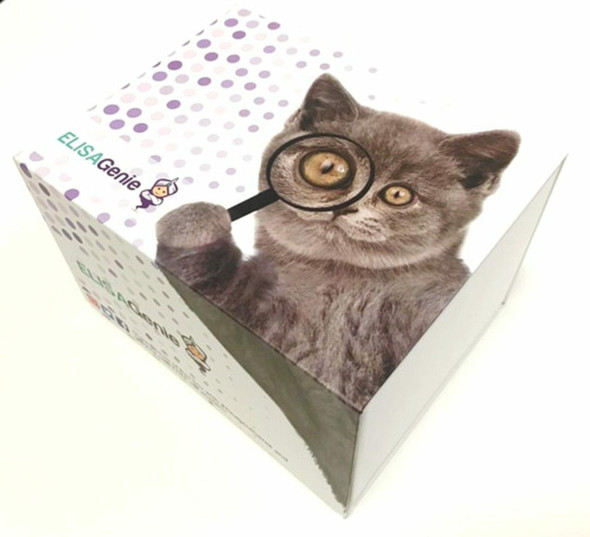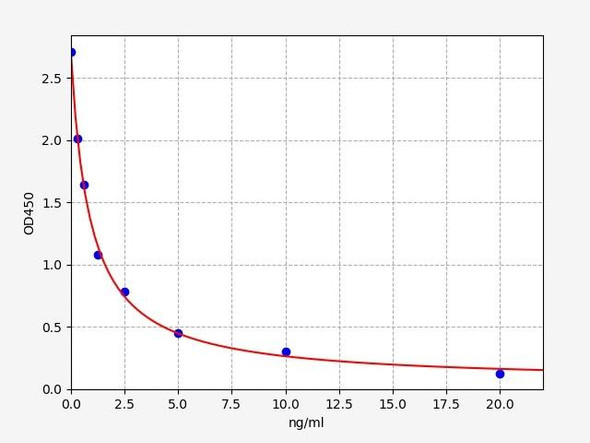Description
Human Neurofibromin (NF1) ELISA Kit
The Human Neurofibromin (NF1) ELISA Kit is specifically designed for the precise detection of neurofibromin levels in human serum, plasma, and cell culture supernatants. This kit offers exceptional sensitivity and specificity, ensuring consistent and accurate results, making it an optimal choice for a variety of research purposes.Neurofibromin is a critical protein that plays a key role in regulating cell growth and division, as well as in maintaining the normal function of nerve cells. Defects in neurofibromin have been linked to neurofibromatosis type 1 (NF1), a genetic disorder characterized by the growth of tumors along nerves and other complications.
By accurately measuring neurofibromin levels, researchers can gain valuable insights into the pathology of NF1 and other related conditions, ultimately aiding in the development of targeted treatments and therapies. The Human Neurofibromin (NF1) ELISA Kit is a valuable tool for advancing our understanding of these complex disorders.
| Product Name: | Human Neurofibromin (NF1) ELISA Kit |
| SKU: | HUEB2551 |
| Size: | 96T |
| Target: | Human Neurofibromin (NF1) |
| Synonyms: | Neurofibromatosis-related protein NF-1 |
| Assay Type: | Sandwich |
| Detection Method: | ELISA |
| Reactivity: | Human |
| Detection Range: | 78-5000pg/mL |
| Sensitivity: | 34pg/mL |
| Intra CV: | 4.3% | ||||||||||||||||||||
| Inter CV: | 7.7% | ||||||||||||||||||||
| Linearity: |
| ||||||||||||||||||||
| Recovery: |
| ||||||||||||||||||||
| Function: | Stimulates the GTPase activity of Ras. NF1 shows greater affinity for Ras GAP, but lower specific activity. May be a regulator of Ras activity. |
| Uniprot: | P21359 |
| Sample Type: | Serum, plasma, tissue homogenates, cell culture supernates and other biological fluids |
| Specificity: | Natural and recombinant human Neurofibromin |
| Sub Unit: | Interacts with HTR6 (PubMed:23027611). |
| Subcellular Location: | Nucleus Nucleus Nucleolus |
| Storage: | Please see kit components below for exact storage details |
| Note: | For research use only |
| UniProt Protein Function: | NF1: a Ras-GAP, highly expressed in developing neural cells. Possesses tumor suppressor activity, presumably by virtue of its GTPase activating domain. Neurofibromin is phosphorylated in response to EGF in CNS cells and cell lines. Defects in NF1 are the cause of type 1 neurofibromatosis (NF1), Watson syndrome, and familial spinal neurofibromatosis. NF1 is one of the most frequent autosomal dominant diseases. Four alternatively spliced isoforms have been described. |
| UniProt Protein Details: | Protein type:Tumor suppressor; GAPs, Ras; GAPs; Nucleolus; Motility/polarity/chemotaxis Chromosomal Location of Human Ortholog: 17q11.2 Cellular Component: membrane; axon; dendrite; cytoplasm; nucleolus; nucleus Molecular Function:protein binding; phosphatidylethanolamine binding; phosphatidylcholine binding Biological Process: negative regulation of Rac protein signal transduction; neural tube development; negative regulation of MAP kinase activity; Schwann cell development; extracellular matrix organization and biogenesis; collagen fibril organization; positive regulation of apoptosis; heart development; negative regulation of transcription factor import into nucleus; negative regulation of neuroblast proliferation; regulation of glial cell differentiation; positive regulation of adenylate cyclase activity; negative regulation of neurotransmitter secretion; skeletal muscle development; adrenal gland development; forebrain morphogenesis; negative regulation of cell-matrix adhesion; regulation of synaptic transmission, GABAergic; myelination in the peripheral nervous system; camera-type eye morphogenesis; induction of apoptosis via death domain receptors; negative regulation of fibroblast proliferation; negative regulation of endothelial cell proliferation; negative regulation of protein kinase activity; positive regulation of endothelial cell proliferation; cerebral cortex development; actin cytoskeleton organization and biogenesis; forebrain astrocyte development; metanephros development; regulation of long-term neuronal synaptic plasticity; negative regulation of osteoclast differentiation; phosphoinositide 3-kinase cascade; wound healing; regulation of cell-matrix adhesion; regulation of blood vessel endothelial cell migration; smooth muscle development; sympathetic nervous system development; positive regulation of neuron apoptosis; visual learning; negative regulation of Ras protein signal transduction; cell communication; negative regulation of cell migration; regulation of bone resorption; negative regulation of MAPKKK cascade; MAPKKK cascade; liver development; regulation of angiogenesis; peripheral nervous system development; osteoblast differentiation; negative regulation of oligodendrocyte differentiation; negative regulation of angiogenesis; pigmentation; spinal cord development; negative regulation of astrocyte differentiation; Ras protein signal transduction; response to hypoxia; artery morphogenesis; brain development; cognition Disease: Neurofibromatosis, Familial Spinal; Watson Syndrome; Juvenile Myelomonocytic Leukemia; Neurofibromatosis, Type I; Neurofibromatosis-noonan Syndrome |
| NCBI Summary: | This gene product appears to function as a negative regulator of the ras signal transduction pathway. Mutations in this gene have been linked to neurofibromatosis type 1, juvenile myelomonocytic leukemia and Watson syndrome. The mRNA for this gene is subject to RNA editing (CGA>UGA->Arg1306Term) resulting in premature translation termination. Alternatively spliced transcript variants encoding different isoforms have also been described for this gene. [provided by RefSeq, Jul 2008] |
| UniProt Code: | P21359 |
| NCBI GenInfo Identifier: | 4557793 |
| NCBI Gene ID: | 4763 |
| NCBI Accession: | NP_000258 |
| UniProt Related Accession: | P21359 |
| Molecular Weight: | |
| NCBI Full Name: | neurofibromin isoform 2 |
| NCBI Synonym Full Names: | neurofibromin 1 |
| NCBI Official Symbol: | NF1 |
| NCBI Official Synonym Symbols: | WSS; NFNS; VRNF |
| NCBI Protein Information: | neurofibromin |
| UniProt Protein Name: | Neurofibromin |
| UniProt Synonym Protein Names: | Neurofibromatosis-related protein NF-1 |
| Protein Family: | Neurofibromin |
| UniProt Gene Name: | NF1 |
| UniProt Entry Name: | NF1_HUMAN |
| Component | Quantity (96 Assays) | Storage |
| ELISA Microplate (Dismountable) | 8×12 strips | -20°C |
| Lyophilized Standard | 2 | -20°C |
| Sample Diluent | 20ml | -20°C |
| Assay Diluent A | 10mL | -20°C |
| Assay Diluent B | 10mL | -20°C |
| Detection Reagent A | 120µL | -20°C |
| Detection Reagent B | 120µL | -20°C |
| Wash Buffer | 30mL | 4°C |
| Substrate | 10mL | 4°C |
| Stop Solution | 10mL | 4°C |
| Plate Sealer | 5 | - |
Other materials and equipment required:
- Microplate reader with 450 nm wavelength filter
- Multichannel Pipette, Pipette, microcentrifuge tubes and disposable pipette tips
- Incubator
- Deionized or distilled water
- Absorbent paper
- Buffer resevoir
*Note: The below protocol is a sample protocol. Protocols are specific to each batch/lot. For the correct instructions please follow the protocol included in your kit.
Allow all reagents to reach room temperature (Please do not dissolve the reagents at 37°C directly). All the reagents should be mixed thoroughly by gently swirling before pipetting. Avoid foaming. Keep appropriate numbers of strips for 1 experiment and remove extra strips from microtiter plate. Removed strips should be resealed and stored at -20°C until the kits expiry date. Prepare all reagents, working standards and samples as directed in the previous sections. Please predict the concentration before assaying. If values for these are not within the range of the standard curve, users must determine the optimal sample dilutions for their experiments. We recommend running all samples in duplicate.
| Step | |
| 1. | Add Sample: Add 100µL of Standard, Blank, or Sample per well. The blank well is added with Sample diluent. Solutions are added to the bottom of micro ELISA plate well, avoid inside wall touching and foaming as possible. Mix it gently. Cover the plate with sealer we provided. Incubate for 120 minutes at 37°C. |
| 2. | Remove the liquid from each well, don't wash. Add 100µL of Detection Reagent A working solution to each well. Cover with the Plate sealer. Gently tap the plate to ensure thorough mixing. Incubate for 1 hour at 37°C. Note: if Detection Reagent A appears cloudy warm to room temperature until solution is uniform. |
| 3. | Aspirate each well and wash, repeating the process three times. Wash by filling each well with Wash Buffer (approximately 400µL) (a squirt bottle, multi-channel pipette,manifold dispenser or automated washer are needed). Complete removal of liquid at each step is essential. After the last wash, completely remove remaining Wash Buffer by aspirating or decanting. Invert the plate and pat it against thick clean absorbent paper. |
| 4. | Add 100µL of Detection Reagent B working solution to each well. Cover with the Plate sealer. Incubate for 60 minutes at 37°C. |
| 5. | Repeat the wash process for five times as conducted in step 3. |
| 6. | Add 90µL of Substrate Solution to each well. Cover with a new Plate sealer and incubate for 10-20 minutes at 37°C. Protect the plate from light. The reaction time can be shortened or extended according to the actual color change, but this should not exceed more than 30 minutes. When apparent gradient appears in standard wells, user should terminatethe reaction. |
| 7. | Add 50µL of Stop Solution to each well. If color change does not appear uniform, gently tap the plate to ensure thorough mixing. |
| 8. | Determine the optical density (OD value) of each well at once, using a micro-plate reader set to 450 nm. User should open the micro-plate reader in advance, preheat the instrument, and set the testing parameters. |
| 9. | After experiment, store all reagents according to the specified storage temperature respectively until their expiry. |
When carrying out an ELISA assay it is important to prepare your samples in order to achieve the best possible results. Below we have a list of procedures for the preparation of samples for different sample types.
| Sample Type | Protocol |
| Serum | If using serum separator tubes, allow samples to clot for 30 minutes at room temperature. Centrifuge for 10 minutes at 1,000x g. Collect the serum fraction and assay promptly or aliquot and store the samples at -80°C. Avoid multiple freeze-thaw cycles. If serum separator tubes are not being used, allow samples to clot overnight at 2-8°C. Centrifuge for 10 minutes at 1,000x g. Remove serum and assay promptly or aliquot and store the samples at -80°C. Avoid multiple freeze-thaw cycles. |
| Plasma | Collect plasma using EDTA or heparin as an anticoagulant. Centrifuge samples at 4°C for 15 mins at 1000 × g within 30 mins of collection. Collect the plasma fraction and assay promptly or aliquot and store the samples at -80°C. Avoid multiple freeze-thaw cycles. Note: Over haemolysed samples are not suitable for use with this kit. |
| Urine & Cerebrospinal Fluid | Collect the urine (mid-stream) in a sterile container, centrifuge for 20 mins at 2000-3000 rpm. Remove supernatant and assay immediately. If any precipitation is detected, repeat the centrifugation step. A similar protocol can be used for cerebrospinal fluid. |
| Cell culture supernatant | Collect the cell culture media by pipette, followed by centrifugation at 4°C for 20 mins at 1500 rpm. Collect the clear supernatant and assay immediately. |
| Cell lysates | Solubilize cells in lysis buffer and allow to sit on ice for 30 minutes. Centrifuge tubes at 14,000 x g for 5 minutes to remove insoluble material. Aliquot the supernatant into a new tube and discard the remaining whole cell extract. Quantify total protein concentration using a total protein assay. Assay immediately or aliquot and store at ≤ -20 °C. |
| Tissue homogenates | The preparation of tissue homogenates will vary depending upon tissue type. Rinse tissue with 1X PBS to remove excess blood & homogenize in 20ml of 1X PBS (including protease inhibitors) and store overnight at ≤ -20°C. Two freeze-thaw cycles are required to break the cell membranes. To further disrupt the cell membranes you can sonicate the samples. Centrifuge homogenates for 5 mins at 5000xg. Remove the supernatant and assay immediately or aliquot and store at -20°C or -80°C. |
| Tissue lysates | Rinse tissue with PBS, cut into 1-2 mm pieces, and homogenize with a tissue homogenizer in PBS. Add an equal volume of RIPA buffer containing protease inhibitors and lyse tissues at room temperature for 30 minutes with gentle agitation. Centrifuge to remove debris. Quantify total protein concentration using a total protein assay. Assay immediately or aliquot and store at ≤ -20 °C. |
| Breast Milk | Collect milk samples and centrifuge at 10,000 x g for 60 min at 4°C. Aliquot the supernatant and assay. For long term use, store samples at -80°C. Minimize freeze/thaw cycles. |








